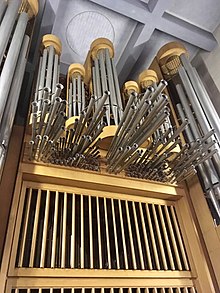St. Agatha (Dorsten)
The Catholic parish church of St. Agatha is a listed church building in Dorsten , a town in the Recklinghausen district in North Rhine-Westphalia .
History and architecture
The building was erected in 1952 in place of the old, destroyed Gothic hall church.
The first church in Dorsten was founded in the 11th century by the Xanten monastery, which until 1721 also had the right to occupy the pastoral position. Initially, the church (ngemeinde) belonged to the Archdiocese of Cologne, and only from 1821 to the Diocese of Münster.
In the place of today's church there was already a church from the 13th century, which was initially built in the shape of a cross, and later expanded into a Gothic hall church with several extensions. The patron saint was initially John the Baptist, and only later St. Agatha. At the end of the 15th century, the Magdalen Chapel was added to the church. In 1719 the church tower was severely damaged in a town fire; the historic bells were destroyed in the fire. They were replaced by three new, baroque bells in 1732. On March 22, 1945, the church was completely destroyed in a bomb drop; the works of art and valuables, which had already been securely housed in the tower in 1943, were destroyed, as was the parish archive.
In 1946 an emergency church was inaugurated in the 500 square meter machine hall of the Fürst Leopold colliery. Planning for the construction of a new church had already begun in 1945, and the Cologne architect Otto Bongartz had presented the first drafts for a church with a mighty west tower and two side towers in the east. It was supposed to be larger than the destroyed medieval church, which had proven to be too small even before the war. The foundation stone was laid on September 24, 1951, and the new church was consecrated on July 7, 1952.
Furnishing
- Three epitaphs from the beginning of the 17th century
- In the baptistery in the tower of the church there is a cylindrical, late Romanesque font from the 13th century. It was probably created by stonemasons from Münster's cathedral building and is made of Baumberger sandstone. The baptismal font is adorned with two ornamental tiles: vine tendrils with vines emerge from the mouths of panther and lion faces. On both friezes there are demon masks and human faces in pointed hats; These are representations of Jews who were obliged to wear cone bags since the fourth Lateran Council. The baptismal font testifies to the marginalization and demonization of Jews that was already widespread at the time. The baptismal font was destroyed in the bombing raid on Dorsten in March 1945; the 80 individual parts were put back together later.
- Vespers made of wood, from the second half of the 16th century
- Holy bishop made of linden wood with old setting from the 18th century
- Silver, gilded monstrance with some figures and an architectural structure
- Next to the stairs to the sacristy is a sculpture of St. Agatha from 1949. It is one of the earliest works by the artist Tisa von der Schulenburg , who lived as Sister Paula in the Ursuline convent in Dorsten.
organ
The organ was built in 1982 by the organ building company Franz Breil (Dorsten). The instrument has 51 registers (3728 organ pipes ), four manual works and pedal , etc. a. three Spanish trumpets . The swell is equipped with two swell steps, each for the lower and the upper part of the work.
|
|
|
|
|||||||||||||||||||||||||||||||||||||||||||||||||||||||||||||||||||||||||||||||||||||||||||||||||||||||||||||||||||||||||||||||||||||||||||||||||||||||||||||||||||||||||||||||||
- Coupling : I / II, III / I, III / II, IV / I, IV / II, IV / III, I / P, II / P, III / P, IV / P
- Playing aids: 3,000 typesetting combinations. Sequencer. Tongue holder.
Peal
There are 5 bells hanging in the tower of St. Agatha. Two bells were cast in 1963, three bells are baroque sounding bodies from 1732. They were transported to Lünen to be melted down at the end of the Second World War and could be retrieved in 1946. These three bells are the only completely preserved baroque bell in Westphalia.
literature
- Georg Dehio : Handbook of the German art monuments , North Rhine-Westphalia . Volume 2, Westphalia, Deutscher Kunstverlag, Munich 1969
- Elke Dißelbeck-Tewes: The memory book of the parish St. Agatha Dorsten , in: Vestische Zeitschrift Vol. 90/91, 1992, pp. 91-113.
supporting documents
- ↑ On the history of the church
- ↑ On the furnishings of the church
- ^ Georg Dehio : Handbook of German Art Monuments, North Rhine-Westphalia . Volume 2, Westfalen, Deutscher Kunstverlag, Munich 1969, pages 124 and 126
- ↑ Information on the organ
- ↑ Information about the bells
Coordinates: 51 ° 39 ′ 38 " N , 6 ° 57 ′ 56" E


